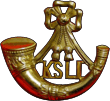Origins and Development.
53rd Foot raised in 1755, it became
the Shropshire Regiment in 1782. The 85th Foot originated
in the Aylesbury area in 1793 and was known as Bucks
Volunteers, the 53rd were the Brickdusts, this was
due to their red facings. Two earlier regiments
having previously had the number in 1759 and 1779.
It was converted to Light Infantry
in 1809 and in 1814 was designated The Duke of York's
Own Regiment of Light Infantry as a result of its
services in the Peninsular War and the Anglo-American
War of 1812-1814. In 1821 it became The King's Light
Infantry after guarding King George IV during a
riot in Brighton. In 1881 they were linked as the
1st and 2nd Battalions, The Kings's Shropshire Light
Infantry. Reduced to a single battalion in 1948.
In 1968 the regiment became the 3rd Battalion, The
Light Infantry.
The 85th converted to Light Infantry
in 1809 , first being The Duke of York's Own and
later in 1821 The King's. The two regiments were
linked in 1881, the 52rd being converted to Light
Infantry and losing its red facings but not its
Shropshire connections, the 85th retained its royal
title and blue facings. The Depot was moved from
Oxford to Shrewsbury.
The KSLI marches were Farmers Boy,
Old Towler and Daughter of the Regiment.The Regimental
Museum is housed in Shrewsbury Castle, some
of the Colours are there with others in the Chapel
of Quarry and St. Mary's Church Shrewsbury.
|
The King's Shropshire Light Infantry,
1865-1912, showing a variety of uniforms
and headgear.
Click Image for
Larger Version
Note: Opens in New Window
|
History.
Raised by Colonel William Whitmore
of Apley, near Bridgnorth, the 53rd proceeded to
North America in 1775, seeing its first major action
in the American War of Independence. It then served
in the Flanders campaign in 1793-4, earning the
battle honour 'Nieuport' shared only with the Royal
Marines. The 85th was part of the British force
that burned the presidential mansion in Washington
in 1814. Subsequently it became known as the White
House after restoration, since white paint was used
to obscure the scorch marks.
Relics of the 85th include the Colour
taken from the James City Light Infantry and the
Guidon of the Harford Dragoons, both captured from
the Americans at Bladensburg outside Washington
on 24th August 1814. The 85th earned the motto,
"Aucto splendore resurgo" (I rise again
with increased splendour) from its distinguished
conduct after the earlier disbandment of the previous
regiments bearing the number 85th in 1763 and 1782.
The 53rd was in India from 1804 to
1823 again during the Sikh Wars, guarding the famous
Koh-i-noor Diamond, which was subsequently incorporated
into the Crown Jewels. The regiment also possesses
a lock of Napoleon's hair, acquired by Captain Poppleton
of the 53rd while acting as orderly officer to the
exiled Emporer on St Helena. There are also relics
of General Viscount Hill, a divisional commander
under Wellington and later commander in chief of
the army, who served in the 53rd as a subaltern.
In 1894 the battalion was in Hong
Kong when plague struck. For the battalions work
in burying the dead and disinfecting housing, each
officer received a gold medal and each enlisted
man a silver medal from the Hong Kong authorities.
In the South African War the 2nd Battalion
travelled some 6000 miles (almost 10,000km) with
the 19th Brigade, taking part in ten general actions
and twenty seven minor actions in five months. The
regiment had eight battalions in service during
WW1. At Bligny on 6th June 1918 the 1/4th Battalion
made a crucial counter attack to re-establish the
line against the Germans, winning the French Croix
de Guerre.
In WW2 Corporal Priday of the 1st
Battalion had the misfortune to be the first soldier
killed in action. After the war, the regiment fought
in Korea and against the Mau Mau in Kenya between
1955 and 1957.
Nicknames
The Brickdusts (53rd) from the original
red facings
The Young Bucks (85th) to distinguish
itself from the Old Bucks (16th Foot)
The Old Five and Threepennies (53rd):
from the regimental number.

